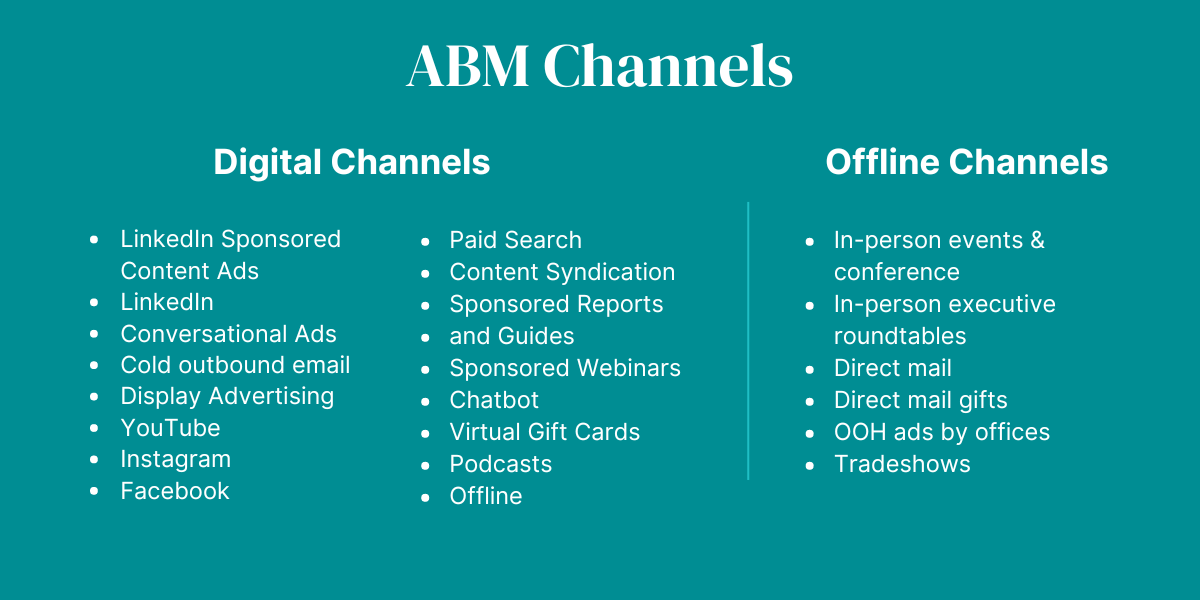We often get asked about Account-Based Marketing (ABM) and where to start, especially for companies moving upmarket and finding that traditional outbound strategies aren't as effective as hoped. ABM can be an effective strategy, even for startups with limited resources and budgets. Here's how to think about it:
Account-Based Marketing (ABM) is not for everyone, but launching an ABM program can significantly boost your ability to engage high-value accounts and accelerate deal cycles. This strategy is most effective under specific circumstances:
- High ACV/Deal Size: ABM shines when you're targeting accounts with a high average contract value. The investment in personalized marketing efforts is justified by the potential returns from these larger deals.
- Long Sales Cycle: If your sales process involves a lengthy cycle, ABM can help maintain engagement and momentum through tailored content and targeted campaigns.
- AE Structure and Bandwidth: Ensure your Account Executives (AEs) have the bandwidth to engage deeply with target accounts. ABM requires a high-touch selling motion, where AEs and marketers work closely together.
- Multiple Stakeholders: Complex sales often involve multiple decision-makers. ABM’s personalized approach helps in nurturing these relationships and building consensus within target accounts.
If you are nodding along, then know that ABM can absolutely work for startups, but it’s critical that you take the time to plan your campaigns, have a clear owner and measurements in place and realize that this is a long term strategy and that is unlikely to contribute to short-term revenue growth.
Still with me? ABM expert Eric MacColl is a wealth of knowledge on this topic and shared his comprehensive ABM playbook which covers a lot of ground.
Let’s walk through the fundamental building blocks of an ABM strategy.
Getting started: Start small, experiment and then grow. When you’re just starting out, find one or two sales reps to champion the program. Turn them into your advocates by gathering insights on what they find most helpful before rolling out too broadly. Efforts to launch ABM often fail when there are too many cooks in the kitchen or too many people to coordinate. You want to get a small tiger team across sales and marketing (and BDRs and CS if relevant) to get engaged on your top accouABm nts and ensure one person owns the program. Plus, you can create internal “case studies” featuring the program after you’ve reached success, making them the hero among their peers.
Pro tip: use tools like Clay, Gradient Works, Propensity and Keyplay to find best-fit prospects.
Choosing Accounts: How many accounts should we choose?
Eric shares a quick rule of thumb to consider when thinking about the number of accounts per AE and the level of personalization you should be aiming for:

If you narrow in on a small number of accounts, you can dramatically increase your level of personalization and the relevance of your message. Where to start? A content audit. Look at your current assets (thought leadership, blog posts, product use cases, case studies, video content, one-pagers, webinars, landing pages, interactive demos, etc.) and classify them to cover your full funnel (TOFU, MOFU, and BOFU) and personas. This allows you to identify gaps in your content strategy and determine what new content you need to create. (Psst. If you're looking for guidance on creating your content strategy from scratch, Stage 2 has pre-built templates for creating a content strategy and editorial calendar.)
Next, think about ways to add an extra layer of personalization or relevance for your target accounts. For example, are the accounts you are targeting all in a similar vertical? Take your top-performing ebook and create an industry-specific version by updating the introduction and customer stories.
Measuring Success: Rethink how you measure your ABM funnel - focus on progression
Remember, you are playing the long game. Reporting on opportunities created and closed won customers won’t be helpful as you get started. Instead, you need to shift your focus to showing progress in your target accounts and get everyone aligned around making meaningful progress each week.
Here are two ideas that Eric shared:
- Measure ICP contact coverage: Eric advises that you “Take a monthly snapshot of what % of your target account list has contacts in your CRM and report on growth month over month. Bonus points if you can break it down by persona.
- Measure account progression in your funnel: for each of the companies on your defined target list - how many have engaged? had a first meeting? taken a demo?madea second contact into calls? Eric shares the following funnel definitions that can be a helpful place to start:
- Unaware: No trackable engagement from anyone at the account.
- Engaged: At least some trackable touchpoint from someone at the account. Typically a web visit, email click, webinar registration, content download, etc.
- Qualified: An action or series of actions across the account making them qualified. Typically if a demo or contact us form has been submitted. Or a scoring threshold has been reached.
- Opportunity: An active sales opportunity has been created for the account and is being pursued.
- Won/Customer: Won opportunity at the account.
- Compare against a holdout group: Measure overall lift by comparing results from engaged accounts with a control group not enrolled in ABM activities.
Off to the races: Go deep with a small set of accounts
You’ve selected a few reps, done the account segmentation and selection work, audited your content and now it’s time to get started. What does it look like to actually get started with ABM?
- Start with contact enrichment and acquisition and ensure you have the right contacts within your target accounts.
- Use AI tools to tailor your messaging and outreach efforts. This enhances relevance and engagement with your target accounts. Eric has had success with tools like Primer, ToFu and Propensity
- Launch campaigns across multiple channels (email, social media, direct mail, etc.) to ensure broad and consistent outreach to your target accounts.

- Set Up Real-time Alerts: Monitor account engagement in real-time to respond promptly.
- Dedicated Budget: Allocate a specific budget for acquiring and engaging these target accounts.
- Celebrate Small Wins: Acknowledge and celebrate new meetings or engagements to maintain momentum.
Launching an ABM program at an early stage startup involves careful planning, coordination, and continuous learning. By focusing on the right accounts, aligning sales and marketing efforts, and using the right tools, your startup can build stronger relationships and accelerate growth.
A big thanks to Eric for sharing his insights. To take these tips with you, we've summarized them into a downloadable ABM Cheat Sheet.


